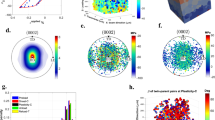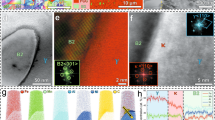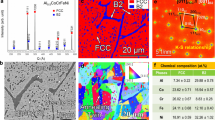Abstract
Two types of brittle-to-ductile transition in tension have been found in chromium. In the annealed condition chromium is brittle at relatively elevated temperatures and low stresses in the strain-ageing region1,2, while in the warm-worked condition2 or after alloying, a transition occurs more typical of other body-centred cubic metals, at low temperature and high stresses3. Explanations of the high-temperature brittleness follow well-known models of dislocation locking4 or modifications involving fine precipitates2; however, these mechanisms do not wholly explain either the abrupt nature of the transition or the low stresses at which it occurs.
This is a preview of subscription content, access via your institution
Access options
Subscribe to this journal
Receive 51 print issues and online access
$199.00 per year
only $3.90 per issue
Buy this article
- Purchase on Springer Link
- Instant access to full article PDF
Prices may be subject to local taxes which are calculated during checkout
Similar content being viewed by others
References
Weaver, C. W., J. Inst. Met., 89, 385 (1961).
Weaver, C. W., Nature, 180, 806 (1957).
Wain, H. L., Henderson, F., Johnstone, S. T. M., and Louat, N., J. Inst. Met., 86, 281 (1957).
Stroh, A. N., Fracture, 117 (Chapman and Hall, London, 1959).
Weaver, C. W., and Gross, K. A., J. App. Phys., 31, 626 (1960).
McNeil, J., and Limb, R., J. Inst. Met., 87, 79 (1958).
Geach, G. A., and Hughes, J. R., Plansee Proc., 1955, 245 (Pergamon Press, London, 1956).
Low, J. R., Fracture, 114 (Chapman and Hall, London, 1959).
Sleeswyk, A. W., Emissary Dislocations (doctoral thesis published by Shell Laboratories, Amsterdam, 1961).
Jacquet, P. A., and Weaver, C. W., C.R. Acad. Sci., Paris (1961).
Cottrell, A. H., and Bilby, B. A., Phil. Mag., 42, 573 (1951).
Author information
Authors and Affiliations
Rights and permissions
About this article
Cite this article
WEAVER, C. ‘Twinning’ and Fracture in Chromium. Nature 193, 265–266 (1962). https://doi.org/10.1038/193265a0
Issue Date:
DOI: https://doi.org/10.1038/193265a0
Comments
By submitting a comment you agree to abide by our Terms and Community Guidelines. If you find something abusive or that does not comply with our terms or guidelines please flag it as inappropriate.



